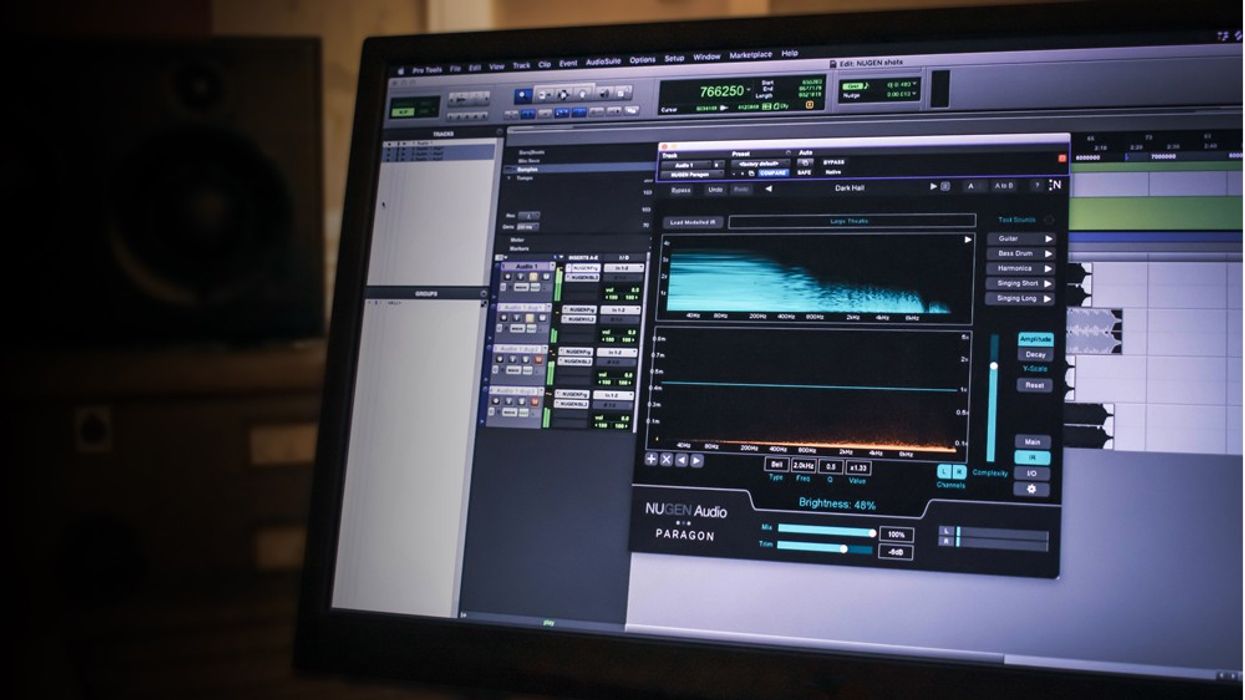Paragon Makes Adding Realistic Reverb To Projects a Whole Lot Easier
Some reverb love for the post sound peeps.

A few weeks ago, Nugen Audio, a software company that specializes in sound tools, released Paragon, claiming it was the "world's first 3D-compatible convolution reverb" tool. With that kind of claim, we had to take it for a test drive.
Paragon is a convolution reverb tool on Red Bull. The tweakability of the program is nearly infinite as it offers full control of the decay, room size, and brightness of the reverb. Better yet, it does so without time-stretching the sound, which means there won't be any artifacts. It also gives you EQ control of the impulse response (IR) and the ability to alter the frequency-dependent decay rate.
What's unique about Paragon is it limits the size of your IR library, which is a good thing. As we mentioned before, impulse response libraries are used to measure acoustic spaces but they can be used to model gear setups or speaker systems. Say you want to match the characteristics of a specific microphone—impulse response allows you to do it. With Paragon, it analyzes and re-synthesizes the 3D impulse response to create new spaces. So, instead of needing dozens of recordings of different-sized orchestra halls, you only need one. It also doesn't use static IR, which will provide you with a wider scope to adjust the sound of the space.
Paragon can operate in 7.1.2, so if surround or Dolby Atmos is your thing, it can handle it. Nugen Audio has also added some unique configurable crosstalk features for each channel so you can add reverb to mono to stereo audio. There's switchable LFE, and a ton more at your fingertips. We were actually quite impressed with its IR capabilities. It does what you'd expect and more.

If you're not familiar with reverb tools, namely convolution reverb, let's break it down, because, marketing aside, reverb tools are a necessity when it comes to mixing sound in post.
Reverb is all around us. It's how sound waves interact with a room or space. It's why we hear an echo in some rooms, or if you're in an anechoic chamber, you won't hear an echo at all.
In the digital space, there are two types of reverb: algorithmic and convolution.
Algorithmic reverb is the more popular of the two and uses algorithms to mimic how audio sounds in a space. It's essentially an effect applied to a sound.
Convolution reverb, which can be called impulse response (IR) reverb, is a little more complex. The process relies on a recorded sample of the acoustics of the space. To create them, microphones and speakers are placed in a room to capture the frequency range, and the response is recorded. This sampled reverb is called the impulse response. Once the impulse response (IR) is recorded, a convolution reverb program, like Paragon, applies that IR to the sound.
If you're a first-timer, don't sweat it. If Niko Pueringer of the Corridor Crew can learn Blender in one day to remake Tron, it should only take a few hours to comfortably navigate Paragon.
Plus, if you've never ever messed around with convolution reverb software, there's no time like the present to learn something new.
That said, there are plenty of reverb programs available. iZotope has Exponential Audio, Avid offers Space. On the more budget-friendly side, Waves has IR1, and OrilRiver is completely free, though it is an algorithmic program. Even the non-linear editors have reverb plugins built into them.
Nugen Audio does offer a trial version of Paragon, but there are some hoops to jump through. You will need a Nugen account and an iLok account. However, you won't need an iLok USB key for the trial. The program is available for both PC and Mac, and once downloaded, you get 15 days to try it out.
You can check out more about Paragon here.
Have any favorite reverb tools? Let us know in the comments below.
Source: Nugen Audio












